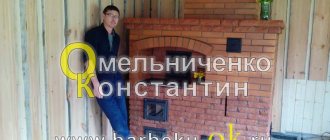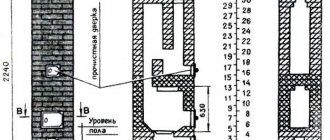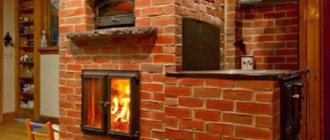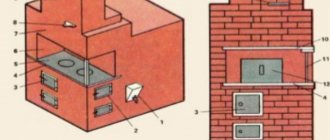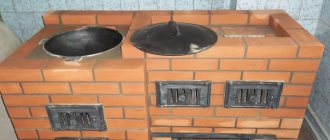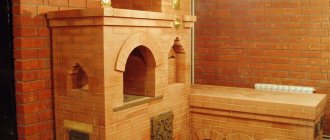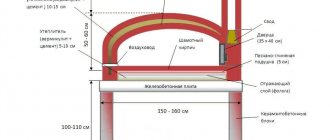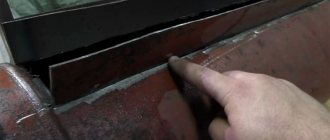Here you will learn:
- Pros of the Russian mini-oven
- What materials will be needed for construction?
- Ordering a mini-stove
- Possible difficulties during manufacturing
- Drying the lined stove
- Stove decor
- Recommendations for use
Fundamentally, a miniature stove is no different from an ordinary Russian stove - it has a similar design, the same functions, the same design. The main distinguishing feature is the size: it takes up significantly less space on the floor due to the fact that the stove and furnace are arranged and located next to each other.
The floor area occupied by the structure is usually no more than 1 m x 1.3 m, but other options are possible, slightly larger or smaller. The height of the structure is the same as usual: the main part at the top smoothly transforms into a cross-pipe and ends with a pipe going into the ceiling.
Both the large cooking chamber and the stove are actively used for cooking. A small firebox heats up quickly enough, so it is used in the summer when heating the entire house is not needed. You can easily place 2-3 pots at once on the burners, and if a large oven is heated, you can bake bread.
It is easier to choose a place for a mini-stove: it can be successfully installed both in the corner and in the center of the room, as well as built into a partition or wall
The stove also stays hot for a long time, so it can be used for reheating or just keeping breakfast or lunch warm.
A special feature of the compact stove is the preservation of two fireboxes, which are used with the same activity. But they are often located on two opposite sides - in this case, a free approach will be required from both the front and the back.
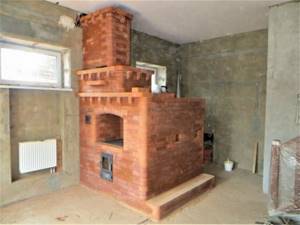
After heating, the walls of the structure retain heat for a long time, and although the mini-stove is smaller in size, the heat transfer is enough to heat a room of 25-30 m²
It must be remembered that a mini-copy does not differ in the level of danger from a large Russian stove, so during construction it is also necessary to insulate the foundation and nearby surfaces susceptible to fire. Walls, wooden floor areas, and the edges of openings in the ceiling are sheathed with metal or asbestos sheets.

Difficulties may arise for those who want to build a bed - of course, the mini-option does not provide a full-fledged place to relax, the occupied area is too small. However, you can build in a niche for drying, just like installing a small hot water boiler
Laying a Russian stove: technology and construction tips
In order to build a simple Russian stove you will need from 1.5 to 2 thousand bricks.
The bricks are laid in rows. A standard stove includes 25-31 rows (excluding the chimney). It is better to lay the first row of the stove with waterproof, heated bricks. The walls of the furnace are one brick thick, and the front part of the cooking surface is half as thick. Wood formwork is usually placed in the oven opening. When laying the vaults of the oven and furnace, it is best to use wedge-shaped bricks. They can be easily made with your own hands, since production involves processing ordinary bricks.
The nuances of drying a lined stove
The laid oven should dry well.
There are several nuances:
- drying is necessary even before the construction of the chimney;
- You cannot fully heat the stove right away - there is a risk of loss of tightness and the appearance of streaks;
- drying should be natural for at least 10 days, with doors and valves open;
- The first times you need to heat it carefully - use little wood, open the smoke valves and close the fireboxes;
- For 1-1.5 weeks, the stove is heated every day, starting with 3-4 kg of firewood and increasing their amount daily by 1-1.5 kg;
- a full-fledged firebox is permitted when, after 2 hours from the start of the firebox, there is no condensation at all on the metal elements.
Methods for finishing Russian stoves
Decorating a Russian stove is done in several ways:
- jointing of brickwork;
- plastering;
- finishing with ceramic tiles or tiles.
Joining on brickwork is the simplest method, which is quite good for modern interiors. The main thing is that this method of decoration should be planned from the very beginning, since the aesthetics of the structure directly depends on the quality of the material and the neatness of the masonry. As a rule, facing bricks with smooth side walls are used for laying external walls.
If the goal is to build a Russian stove according to ancient canons, then it must be plastered with a special clay mortar with the addition of chaff. After drying, the outer surfaces are covered with a solution of white clay in water. Such whitewashing is an environmentally friendly coating that is safe for others. In addition, thanks to it, the basis is prepared for the final finishing - painting. The patterns that cover the walls of the stove can repeat a national ornament or scenes from fairy tales, represent floral curls, stylization of Gzhel, Khokhloma, etc. - it all depends on the created mood and preferences of the owner. A wide selection of plaster mixtures allows you to replace the old composition with a more modern “bark beetle” or “lamb beetle”.
For finishing with ceramic tiles, only heat-resistant types of tiles are used - terracotta, majolica, heat-resistant clinker or porcelain stoneware. In addition, Russian stoves are often lined with tiles. Note that although decorating with ceramic tiles is one of the most beautiful and practical methods of finishing, after it the arrogance and luxury of the “Dutch” begins to be visible in the design, and not everyone will like this.
Stove decor
The Russian mini-stove can easily fit into a wide variety of home decor. It can be painted and painted without much effort, giving it uniqueness and special charm. When the stove has already been built, in any case it makes sense to finish it, because the surface of the brick is rough and will accumulate dust and dirt.
Finishing work can be carried out in different ways: whitewash, paint, apply plaster, veneer with ceramic tiles or make a beautiful painting. It all depends on your imagination.
To paint, the surface of the stove must be rubbed down. After this, it is treated with a primer. Paint is applied over the dried primer. It should be chosen special - heat-resistant. All materials can be freely purchased in stores and markets.
For whitewashing, use slaked lime, to which you need to add blue.
Clay-based plaster can be applied to the surface of the stove. This method has been used since ancient times. Repair of such coating must be done every year.
Before tiling the stove, you need to remove dust from the surface and clean the seams.
Then the mesh is attached and the solution is applied to it. Then the tile itself is laid.
To paint the stove you need sandpaper, chalk, brushes and your imagination. Original patterns can now be easily found in various sources.
You can do this work yourself or hire a specialist.
Having made a high-quality stove, you will receive a magnificent heater for your home, which will create unique coziness and comfort.
Nuances of laying Russian stoves
In the case when a foundation is designed, it must be done efficiently, controlling the horizontal level of the base under the stove. After it is ready, the main stage of work begins. A drawing can help you figure out how to properly assemble a Russian stove. The main thing when laying bricks is to adhere to the order.
To make the design as safe as possible, a real Russian oven is made absolutely airtight. For this reason, cracked bricks are not used.
The thickness of the seams between the rows can be from 5 to 8 millimeters. When ensuring tightness, stove makers do not recommend using clay, coating the walls with it from the inside. The fact is that after this, during the operation of the unit, soot begins to accumulate on them and the degree of their thermal conductivity decreases.
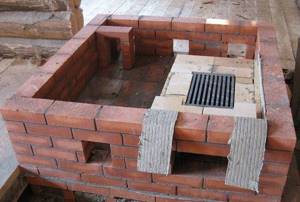
External walls are made of one or one and a half bricks, and internal walls are also made of half a brick. If you make the internal walls a whole brick, they will turn out to be too thick and will take longer to warm up, which means that the operating principle of the Russian stove will be disrupted and fuel consumption will increase.
How to build a Russian stove with your own hands: ordering and step-by-step laying
If you have not previously encountered bricklaying, and have only theoretical ideas about construction, you should not start creating a device.
For work you will need a level, a plumb line, a trowel, a rule and a square with a tape measure.
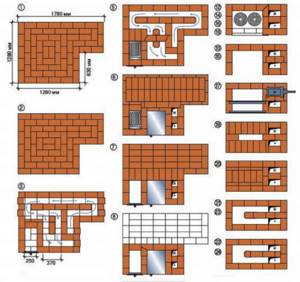
Photo 5. Option for arranging a Russian stove with a stove bench and tiles for cooking. Contains 24 stages.
First, a layer of waterproofing is laid, the perimeter of the base of the device is laid out on it, all parameters are checked, and the order is carried out according to the diagram drawn on paper.
Reference. Each brick needs to be kept in a bucket of water for a while for better adhesion to the mortar. During work, you must constantly check that geometric proportions are observed. There is no need to rush; if difficulties arise, you can involve a knowledgeable person; the opinion of an experienced stove maker will always come in handy.

The first continuous row is laid out, chipped bricks are placed in the corners to ensure the ligation of the rows. Next come the internal walls, as well as the arched opening for the heating. From the 5th row a semicircular arch is formed; formwork will be required here.
Further rows of sidewalls consist of brick halves. Rows 11 and 12 complete the formation of the base. The vault goes up to the 20th row. 21 and subsequent rows are the basis of the bed. In the 26th row a door is installed, in the 32nd row a damper is installed, and above the place for joining the chimney is indicated.
The process of constructing a small-sized furnace
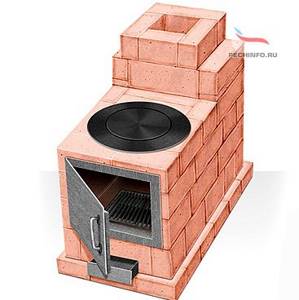
Due to the relatively light weight of the mini-oven, it does not require a foundation, but in this case a thick, durable board, well secured to the joists, should be used for the floor.
Order of masonry
- The first stage is traditionally choosing a place and preparing it for the construction of a furnace. To do this, you need to lay a piece of plastic film, roofing felt, hydrosol or glassine measuring 78 by 53 centimeters on the surface. Pour dry sand on top of the litter (layer thickness 1 cm) and level it.
The first row of bricks is laid out on the sand (12 bricks are used without fastening) strictly horizontally, which can be checked with a level. On top of the first row we thinly apply a clay solution and install the blower door. Pre-wrap the door with a piece of asbestos cardboard or wrap it with cord. Secure it with wire.
- We are laying the second row of our stove.
- We lay out the third row of fireclay bricks. We install a grate on it, which will be located strictly above the ash pit.
- In the fourth row, the bricks are laid edgewise. And inside the chimney, a stand is mounted on which the internal partition will be installed. When laying the back wall of the stove, do not use clay, but use so-called knockout bricks (for this they should protrude slightly outward).
- The next essential element of any stove is the firebox door. Wrap it with asbestos cord before installation. We secure the door with wire, use two bricks for temporary fixation: one on the back, the second on the first, and install the door on top of them.
- We lay the bricks in the fifth row flat, following the contours of the fourth row.
- We place the bricks of the sixth row on edge, and then rub the walls of the oven with a damp rag.
- For the seventh row, we again lay the bricks flat. At the same time, in order to ensure a connection between this and the next row, you need to start with three-quarters. Then place two bricks on edge and begin building the back wall.
Oven with hob
In the simplest version, this design has small dimensions (width 2 and depth 3 bricks - 78x53 cm). However, even in such a limited area it is possible to place a single-burner stove.
Work goes smoothly when you have everything you need at hand.
Therefore, purchase the following materials and accessories in advance:
- Solid red brick – 107 pcs;
- Blower door – 1 piece;
- Grate – 1 piece;
- Single-burner cast iron stove – 1 piece;
- Fire door – 1 piece;
- Pipe valve – 1 pc.
Fire bricks are not needed for a wood burning stove. Buying it is a waste of money. But red should be chosen carefully, discarding cracked and uneven ones.
Preparation of the solution
The masonry mixture is made by mixing four parts clay with one part water and adding eight parts sifted sand. The normal consistency is determined simply: the solution easily slides off the trowel, leaving no drips on it. When laying, it should not leak out of the seams.
The volume of the mortar is determined based on the amount of brick. With an optimal seam thickness (3-5 mm), one bucket is enough for 50 pieces.
Having prepared the masonry mixture, you can begin laying the foundation. Its width is made 10 cm larger than the width of the oven. The height of the foundation is selected so that the bottom of the first row of bricks is at floor level.
If the underground is deep enough (50-60 cm), then there is no need to dig a hole for the foundation. It is enough to make formwork on the ground with a plan size of 76 x (51 + 10 cm). Two layers of roofing felt are placed on its bottom to protect it from moisture. Having laid the concrete, it is given a week to gain strength, after which they begin laying.
The dimensions of the stove with hob we are considering are 3 x 1.5 bricks (76x39 cm).
Expert advice: lay out each new tier of brick without mortar (dry). After adjusting the bricks to size, you can begin laying.
The first row is placed on a layer of clay mortar (4-5 mm). Having leveled the base, lay out the second one, leaving space for the blower door.
Before installing the door, you need to screw a soft wire to it and put its ends into the seams for better fixation.
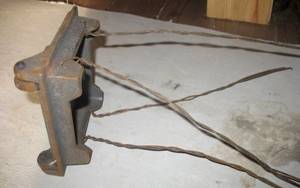
To compensate for the thermal expansion of the metal, a gap is left between the door and the brick. Before installation, its frame is wrapped with wet asbestos cord.
The third row is laid by overlapping the seams of the second. At this level, a grate is installed in the firebox.
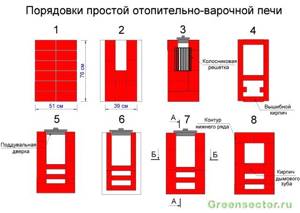
The fourth row is placed on the edge, observing the ligation of the seams, and the walls of the combustion chamber are formed. Behind it will be the first and only smoke circulation (see section A-A in diagram No. 2). To clean its bottom, a so-called knockout brick is placed in the rear wall without mortar, which is periodically removed to remove ash. Inside the chimney, two stands are made from pieces of brick to support the internal partition.
The stones of the fifth row are placed flat, leaving space for the firebox door. In the back of the stove, in order, we see the walls of two smoke channels. During work, their surface must be thoroughly cleaned with a wet cloth to remove any clay protruding from the seams. This is an important condition for ensuring good traction.
Helpful advice! When focusing on the order drawings, do not forget to look at the two sections of the stove. They will help you better imagine its design and not make mistakes when laying out the bricks.

Having raised the masonry up to the eighth row, they close the furnace door, placing wire in the seams to secure its frame. At the same level, in the back of the fuel chamber, a brick with a beveled end is placed - a smoke tooth. It improves heat output by preventing flue gases from quickly escaping into the chimney.
Standard Russian stove: dimensions
The dimensions of a Russian stove depend on its type. So, the most cumbersome stoves will be those with a fireplace and bottom heating; the stove is rough (rough). Such designs have undeniable advantages: they are multifunctional, look attractive and can heat a large room. In addition, such stoves can be easily placed outdoors. But, unfortunately, they cannot always be installed in the house.
A classic Russian stove has a width of 150 and a length of 200 cm. At the same time, the stove bench in a traditional stove should be located at a height of 180 cm, and the hearth should be 45 cm.
The small Russian stove is 153 cm wide and 165.5 cm long. The Little Housekeeper is 100 cm wide and 130 cm long. And the popular “Swedish” Buslaeva is even smaller - 116x90 cm. At the same time, the location of the hobs and crucible determines the height of the housewife.
That is, the stove must be of such power that it is capable of providing the house with heat throughout the night, until the next fire. In order to carry out calculations, you can use generally accepted data, according to which for heating a room up to 10 square meters. you should choose a stove with dimensions of 150x150x200 cm.
Other oven options
Russian stove with stove bench and stove
In addition to the classic version, there are other modifications.
Russian stove with stove bench and stove
This model is the most popular because it allows you to heat the room and cook food in the usual way. According to the scheme of a Russian stove with a stove bench and a stove, the well is first laid, then the door and vent are mounted (rows 3, 4), the stove is installed on the 9th row. Everything else is according to the template.
d24945d45da500c4f38b4237f1a98304.jpe
Mini Russian oven
Due to the fact that the furnace and the stove are adjacent, the dimensions of the furnace are significantly smaller - no more than 100 x 130 cm. The height of the structure is the same as that of the classic model; the overpipe ends in a pipe that goes into the ceiling.
Russian stove with fireplace and stove bench
This model is very complex; its laying will require not only knowledge, but also experience. The formation of fireplace channels begins already from the 2nd row. (they will require 14 doors and a blower door), and ends on the 38th row.
Design of a Russian stove
Any mistake made during the construction process leads to the fact that the entire structure has to be redone. A diagram of the laying of a Russian stove, which is attached to the drawing and can be very different, can help in this matter.
Based on their size, these heating units are divided into mini, medium and large. They are used for heating and cooking. They definitely have a bed. To build them yourself, you need to study how a Russian stove works.
If you look at the diagram of a traditional design, you can see that it consists of:
- ovens used for drying firewood are not always made;
- a cold stove for storing kitchen utensils, it may also not be there;
- pole - a niche located in front of the crucible. A hob is placed in it. If the stove is located in a different place, food is kept in the pole to keep it warm;
- hearth - the bottom of the crucible. It is built with a slight slope towards the entrance to the chamber to make it easier to move the dishes in it.
- a furnace or cooking chamber used for heat-resistant cookware and fuel. The chamber arch is similarly made with a slight slope towards the entrance. Due to this design feature, hot air collects under the ceiling, due to which the stove bench and side walls warm up;
- cheeks – the front wall of the furnace;
- oven mouths - holes between the cheeks;
- cross-pipe - a niche above which the smoke exhaust pipe begins;
- views - a window with a door that serves to block the chimney. Using it you can get to the damper that regulates traction;
- a bench located behind the chimney above the crucible. When the oven is running, it warms up.
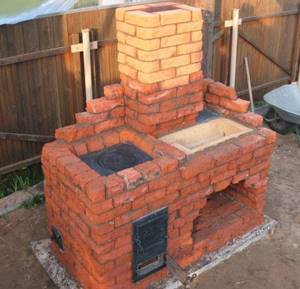
In the diagram of the laying of a Russian stove with a stove, you can see different departments. Their presence allows you not to heat the entire room in the summer, but to use exclusively the hob. As a result, a pleasant microclimate is maintained in the house and fuel consumption is reduced. In winter frosts, all departments are heated in the stove, and then not only the oven, water and stove are heated, but also the house itself.
Before you build a Russian stove with your own hands, they carry out a number of preparatory activities, which begin with choosing its location.
Do it yourself or order work
Does it make sense to take on such complex work yourself? How much does the work of an experienced and reliable stove-maker cost? If 100% of the cost of materials, as is customary in general construction work, then it is not that expensive.
By no means, not twice as much against the material. You can come across offers to build a stove for 20,000 rubles, but this is obvious nonsense. Let's try to figure it out ourselves.
Russian stove with stove
A stove maker works in mid-latitudes for six months, and always with an apprentice. Considering their employment at 100% of working time, the salary of a master at 25,000 rubles, and an assistant at 15,000, and the work completion time is 7 working days (this is a completely realistic period), we find that a simple stove will cost no less than 45,000 rubles, and a Russian stove with a stove and water heater (see figure) at 55,000-60,000 rubles.
But in a week it will be possible to heat it. There is only one condition: the master must tell where, when and to whom he has already installed the stoves, and they must be inspected personally. Good masters always stock up on recommendations, and if they hesitate and mumble, it’s better to turn to someone else.
Stove with stove and stove bench, its dimensions
The main distinguishing feature of such a device is the large dimensions of the furnace. In order for an adult to fit on the floors, the length of the entire structure must exceed two meters and the width one and a half meters. The bed itself is located above an elongated furnace, which ensures a constant flow of heat.
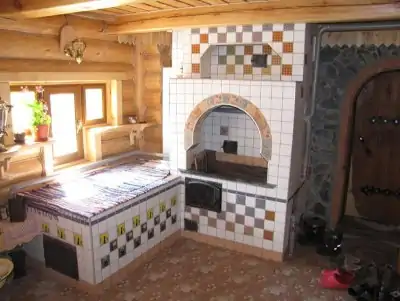
Previously, in traditional models, the floors were located under the ceiling, at a height of about 1.8 m, and were climbed onto them using an attached ladder.
This ensured longer preservation of heat - when the hut cooled down in the morning, on the floors, due to the distance from the floor, the temperature was still quite high.
Nowadays, the bed is placed at a comfortable level of about one meter, because modern materials have better thermal insulation of the house.
Reference. In previous years, a high furnace was traditionally built - in addition to heating functions, it was used as a home mini-bath, so it had to accommodate a person, which also influenced the height of the floors.
The scheme, which includes both a hob and a bed, remains the most common. To build such a structure, lightweight schemes have been developed that even a not very experienced builder can handle. The disadvantage of such a stove will be the reduced efficiency of heating the room compared to other models.
Calculation and production of the foundation
Even a small Russian stove needs a solid foundation. Simply reinforcing the floor will not be enough; you need to build a structure from small reinforced concrete blocks, stone, or pour a reinforced concrete slab. It must be separated from the foundation of the house. To determine the depth of the support, it is necessary to assess the type of soil, its level of freezing and the height of soil water.
Expert opinion
Nikolay Davydov
Stove maker with 15 years of experience
For example, in the Moscow region, the soil freezes to about 1.4 meters in winter. This means that the foundation for the furnace must be no less deep. The width and length must exceed the dimensions of the base of the stove body by at least 15 - 20 cm.
Thus, for a small Russian stove of this model, the dimensions of the foundation will be as follows:
- width - 130 cm;
- length - 150 cm;
- height - 160 cm.
Accordingly, to construct a monolithic slab, 3.0 m3 of concrete will be required. You can buy it at a factory with BRU or make it yourself by purchasing for these purposes:
- cement M400 - 0.97 t;
- sand - 1.6 m³;
- crushed stone - 3.2 m³.
The work itself is carried out in the following sequence:
- dig a pit with a depth of 1.75 - 1.8 m;
- compact the bottom and pour a 15 cm layer of crushed stone;
- install formwork from unedged boards with the laying of waterproofing material along its internal surfaces;
- install a reinforced frame from two rows of metal mesh with a cell size of 15x15 mm, which are connected to each other by vertical sections of reinforcement;
- pour the concrete mixture into the formwork with layer-by-layer compaction using the tamping or bayonet method to remove air bubbles;
- level the upper plane of the structure.
The formwork can be dismantled after about a week, and further waterproofing work is carried out after 25 - 28 days, when the concrete has gained full strength.
Trial fire
After drying is complete, perform a test fire in the following sequence:
- the combustion chamber is loaded as much as possible with dry wood, laying it in dense rows and set on fire. At this moment, the valve should be fully open, and the wellhead valve, on the contrary, should be tightly closed;
- after the first batch of firewood has burned out, the next portion of wood is loaded, but only 2/3 of the furnace is already filled;
- The intensity of fuel combustion is regulated using a valve;
- Complete closing of the valve is possible after all the firewood has burned out and the formed coals have gone out.
The next fire can be started only after the stove has completely cooled down.
The firebox is the heart of the stove
The firebox consists of two parts:
- firebox;
- bakery (cooking chamber).
In small stoves (124 x 178 cm) the bottom is laid out with a rise to the rear wall of 6-9 cm evenly, and in medium (147 x 213 cm) and larger (160 x 231 cm) with a break in the middle or far (2/ 3) parts. This is done to ensure that the dishes stand evenly on the surface. The crucible must have a slope underneath. By the way, Domostroy states that the height of the beds (beds) should be 142 cm.
Before you make a Russian stove, you should decide on its parameters. The dimensions may vary somewhat, depending on the size of the brick - an even amount should be laid out for all dimensions (length, height, width), taking into account the clay mixture. Stoves in which the firebox on the sides also narrowed 6-9 cm towards the mouth are heated better.
“Aerobatics” is considered to be the execution of the crucible arch in the form of a three-center barrel (smoothed dotted line in the first photo), and not hemispherical and the expansion of the crucible in the middle part. Then no sparks are formed, the stove does not smoke, the fuel burns completely - 100%.
Sectional diagram of a stove on a wooden base Source stroyfora.ru
Recommendations for using a small stove
In order for the stove to be useful and save money, it is necessary to monitor its condition. Even a minor crack increases the loss of efficiency. For better heating, use only dry wood for kindling. Be sure to close the view.
Major cleaning of soot is carried out once - in the summer; in winter, minor cleaning is done, but at least 3-4 times per season. Accumulated soot reduces the heat output of the device. If the viewer, valves or door are faulty, you cannot light the stove, because they control the draft and help carbon monoxide evaporate.
Despite all the nuances in the construction and operation of a mini-oven, it acts as an excellent heating device and can compete with modern gadgets in the speed and delicacy of preparing many dishes. It’s not for nothing that our ancestors considered the stove to be the soul of the house and placed the structure in the middle of the hut.
Not even a few centuries passed before she returned to us, only in a slightly different form. But its small size is not the main thing, because in terms of its functions and the wonderful atmosphere that is created in every home, the device is very similar to the good old Russian stove.
Russian style stove dimensions
Before constructing a furnace structure, the site for the construction of a heating structure is always first selected. A Russian-style stove can be located in the corner of the room or along one of its walls. The dimensions of the heating structure depend on the size of the room. These parameters are also affected by the reliability of the foundation.
Nowadays, they often begin to build a stove in an already built house. This is not quite the right option. After all, it is more convenient to thoroughly think through the heating structure at the design stage of a residential building. However, even in this case, craftsmen will always build an effective stove. It can have the following design:
- Mini Russian stove, the width and length of which are 1240 mm and 1780 mm, respectively. This option is suitable for construction in a country house, under a canopy or even in a summer kitchen.
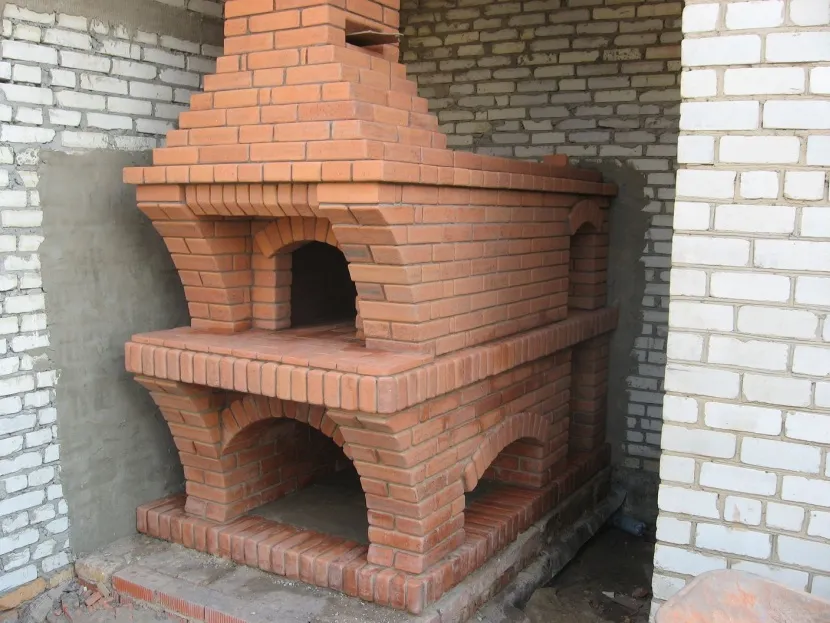
Miniature Russian stove design Source blogspot.com
- A medium-sized heating structure, also called a home stove. Its dimensions are 2130*1470 mm. This option is suitable for heating a house up to 40 m².
- Full-size heating structure with dimensions 3250*2250 mm. Such a stove is capable of heating a large one-and-a-half-story residential building.
On a note! The dimensions indicated above are unusual even for some stove makers. However, experienced specialists know well that previously the length was measured in arshins. Therefore, if you use not millimeters, but the ancient system of measures, then it turns out that a Russian home stove, the dimensions of which are now 2130 * 1470 mm, previously had dimensions of 3 * 2 arshins.
The above dimensions of a Russian-style stove are only recommended dimensions. When constructing such a heating structure, it is more important to maintain proportions when laying the vault, hearth, furnace and chimney. In the latter case, you need to lay out a channel of a suitable cross-section to ensure effective traction.
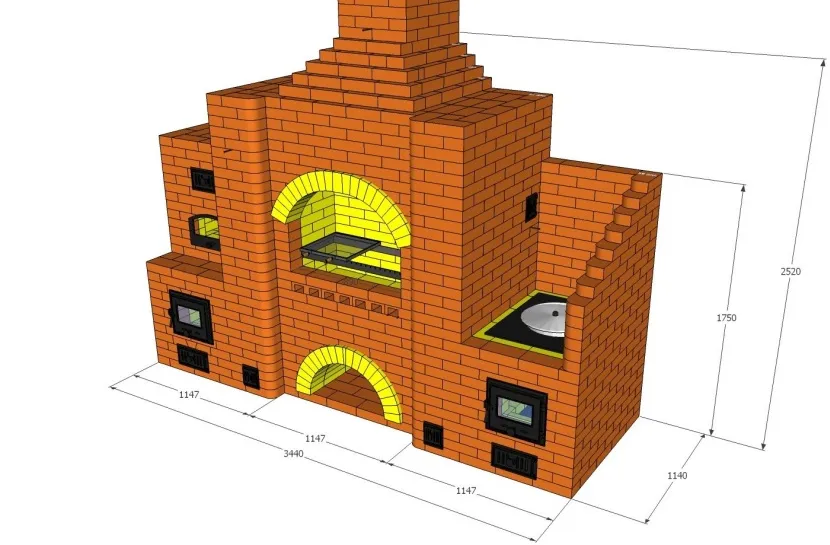
One of the stove size options Source ps.494444.ru
Preparatory work
Before you start building a Russian stove, you should make sure that everything you need is available.
Selecting a location
A lot depends on the choice of place to build a furnace. It is necessary to maintain a gap of 30-40 cm to walls made of flammable material or provide them with protective cladding with asbestos. Gaps will also be required for access to the outer walls of the stove for the purpose of inspection and repair.
A heavy unit weighing several tons requires a solid foundation (foundation) protected from ground moisture. A place is provided in advance where the chimney will pass through the ceiling and roof. There should be no ridge or rafters here.
Masonry tools
Basic working tools for a stove maker:
- a narrow trowel (trowel) for laying mortar and cleaning excess from seams;
- a hammer-pick to give a solid brick the required shape;
- building level and plumb line.
To mix the solution you need a shovel and a container.
Stove maker's tool
Now cutting bricks into wedges, removing corners and grinding the cladding is done with a hand-held power tool (grinder) with diamond wheels. This greatly simplifies the work of the master.
Necessary materials
Basic materials for constructing a reliable fireplace: brick and refractory mortar
Their quality is given close attention. You will also need: cast iron for doors, dampers, latches, grates and a hob
Brick selection
The correct selection of bricks for the job is a key factor in the efficiency of thermal output and the long service life of the future fireplace. Therefore, it makes sense to purchase red clay bricks of the M150-M200 brand only of the first grade. Hollow material is unsuitable for stove masonry.
Bricks with obvious signs of defects are also not suitable for such work:
- non-compliance with the standard (230x125x65 mm), to which all standard orders are oriented;
- with traces of burns, warping, shape and surface defects;
- with shells after the release of gases;
- having cracks and burrs from cutting.
Special grades of premium quality bricks, called hearth bricks, are sold individually and are ideal for laying stoves.
Foundation
The base of a heavy furnace is placed on a concrete foundation, which is cast over a compacted crushed stone bed in a hole up to half a meter deep. Horizontal waterproofing from groundwater is made of 2 layers of roofing felt on bitumen mastic.
Masonry mortar
The requirements for a solution suitable for furnace work are seriously different from the usual ones.
The material is required:
- resistance to high temperatures;
- coefficient of thermal expansion as close as possible to that of masonry bricks.
Refractory mixture for laying stoves
Since the quality of the clay plays a leading role here, it is better to buy a ready-made dry mixture at a hardware store.
Checking the quality of clay
The suitability of clay for stove masonry can be checked using a folk method. From the solution, make a spherical lump the size of a child's fist and slowly squeeze it between two planks. If the clay is of high quality, the lump will crack only after being compressed to half its size. Skinny, unusable clay does not deform at all, and material of average condition will burst after being compressed by about a third.
Required Tools
You need few tools; they can be easily purchased at any hardware store:
- trowel, or as it is also called, trowel;
- convenient hammer-pick;
- building level;
- roulette;
- plumb line
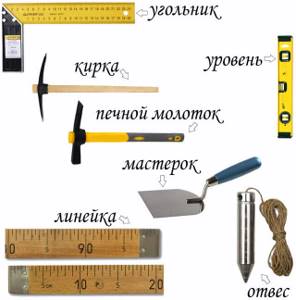
In addition, during the work you will need:
2 buckets (for water and solution), a construction sieve, a trough where to sift the sand.
Features of stove heating
Stove heating has a number of advantages, thanks to which wood-burning brick stoves have not lost their popularity for several centuries. The most important advantage is the ability of the ceramic bricks from which the stoves are made to accumulate and release heat for a long time.
At the same time, radiant energy useful for the human body is released into the space, giving a feeling of warmth and comfort. With regular heating during the cold season, the house is always warm and dry, and natural ventilation is formed due to the stove draft. In hot weather, the stove, on the contrary, cools the rooms by removing excess heat into the ground and air through the foundation and chimney.
In addition to creating a comfortable microclimate, a brick oven can provide additional functions, the availability of which depends on the design:
- cooking - boiling, frying, stewing and baking;
- drying clothes, shoes, food;
- heating beds for sleeping;
- opportunity to admire the open flame.
Furnaces that provide several functions are called combined. These types of stoves include heating and cooking stoves, fireplace stoves, as well as several popular basic models, including the Russian stove.
Stove heating also has disadvantages, including the inability to effectively heat remote rooms. Therefore, in large houses, they usually install several stoves with separate or combined chimneys or combine stove heating with other types of heating.
In compact houses consisting of one or several rooms, the stove is usually located in the center, so that its walls are located in all rooms. The hob and oven are placed on the kitchen side, the stove bench is in the bedroom or nursery, and the open fireplace is in the living room or dining room.
Advantages of a Russian stove with a stove bench for a country house
A full-fledged Russian stove is multifunctional; it is used:
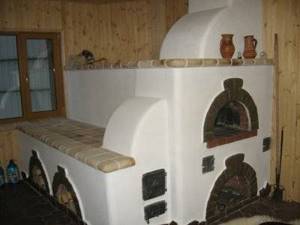
- for heating the house;
- for cooking food;
- as a sleeping place;
- for the effective treatment of a number of diseases.
The heat transfer of the device reaches 75-80%; in terms of this indicator, the device can only be compared with gas boilers running on mains fuel.
The heat generated by a Russian stove does not dry out the air, does not burn oxygen and is evenly distributed throughout all rooms. Due to the high heat capacity of the materials, a comfortable temperature in the house is maintained for up to 12 hours after the last installation of firewood.
A sound and restful sleep on a stove bed gives strength and helps fight colds. With rheumatism, radiculitis and other diseases of the musculoskeletal system, the pain recedes almost immediately. The device not only feeds and warms, it also heals!
The device is easy to use. It can be heated with firewood, wood waste, coal, or pressed materials in briquettes, the cost of which is usually low.
The service life of the device is practically unlimited. A Russian stove adds color to the interior of any home; even in a modern cottage it will become the center of attention and a place around which company will gather for a pleasant pastime.
Important! The building also has its drawbacks, these include the need to procure raw materials for heating
Possible complications for the stove maker
In a country house built according to a standard design, the location of the stove, the chimney outlet, and convenient places for maintenance and operation are usually provided in advance. It is much more difficult to install a heating and cooking unit in a house built according to an individual idea. It is even more difficult if the house has already been built.
It happens that after choosing what the owner thinks is a good location for the stove, and even after building the foundation, they suddenly discover that the chimney will cross the floor beam or rafter. What to do in such a situation?
The way out in this case involves two difficult and rather expensive options. In the first of them, you will have to sort out the ceiling and change the position of the beams and rafters, in the second, you will have to demolish and rebuild the foundation of the stove.
In order to eliminate such troubles, before marking and building the foundation in a built house, it is necessary to determine whether the chimney will not violate the integrity of existing structures. If it is possible and has access to beams that have not yet been sheathed, you need to use a plumb line to check the exact position of the components of the marked furnace.
If in a house you are building with your own hands, it is most convenient to place a brick oven in a place whose projection intersects the elements of the roofing system, it is better to move them. In general, of all the options, it is advisable to choose the one that will be easier and cheaper to implement.
When designing a stove and selecting a suitable model, the following rules should be taken into account:
Improved heater options
Many Russian masters were involved in the modernization of the classic stove - I. Kuznetsov, I. Podgorodnikov, A Emshanov, A. Batsulin. The essence of the changes is as follows: the details of the old design were taken as a basis - the vaulted furnace, the bend and the high above the mouth. New functional elements were added to them:
- Instead of a hearth, a hob is placed, and a small flood is arranged below. A parallel summer passage shaft is laid out, connected at the top with the main smoke collector.
- Hot gases from the additional firebox are directed through smoke circulations made in the lower part - the stove. Then the combustion products are discharged into a common pipe.

An example of modernization - in winter mode, gases from the furnace and furnace heat the lower part of the structure
- At the end or on the sides of the furnace, vertical channels are installed, again leading to the lower zone under the firebox, then into the chimney.
- The channels from the firebox go into the attached heating panel and out through a combined pipe.
- The firebox is made from the bottom of the furnace and communicates with it through a grate installed in the hearth (bottom) of the main firebox. Gas ducts from the furnace penetrate the furnace and converge into a vertical shaft leading into the chimney.
Note. The changes made allow the stove to be heated in two ways: in Russian (the smoke comes out through the mouth and high) and in the heating and cooking mode (gases move around the channels).
We tried to clearly describe common concepts; there are many more existing options. The purpose of the changes is to improve heat transfer and functionality of the basic design. If desired, a water circuit register or an oven is mounted inside the flues (the cabinet is placed next to the firebox).
Now we will analyze the updated options in detail using specific examples - with drawings and procedures.
Installation of a mini stove
Brick is a traditional stove lining material that has been used for centuries. A mini brick oven is made specifically from bricks, but it is best to use two types of them during construction.
- To build a working one, it is often worth using fire-resistant material. It can withstand even a coal fire.
- Facing material is also quite suitable for finishing.
Making the masonry Having prepared the required amount of bricks, you can begin work, the instructions are outlined below:
First of all, you should decide on a place for the mini-oven. Its effectiveness largely depends on this. A mini brick stove for a bath will occupy an area of about 800x550 mm. You just need to lay a fireproof layer, as well as a layer of waterproofing. As a waterproofing layer, you can use roofing material, and as a fireproof layer, if the base is wooden, you can use sheet asbestos. A layer of sand about 10 mm thick is poured onto the waterproofing layer. The first row of bricks is laid on top of the sand, without using mortar. This row is leveled strictly horizontally, hammering in the exposed bricks using a rubber hammer. A thin layer of clay mortar is applied to this brick row and the blower door is immediately installed. The door is set strictly horizontally and strictly vertically, after which it is securely fixed. After fixing it, you can start laying out the second row. The 3rd and subsequent rows are laid out with refractory bricks (fireclay). After laying out the 3rd row, a grate should be installed, which should be located in the center of the blower. The 4th row is laid out in a quarter of a brick (on the edge), regardless of how the previous rows were laid out. The back wall is laid out without mortar. These bricks will be removed later. After the 4th row, they begin to install the firebox door. It is installed in such a way that it opens from bottom to top. It is attached in the same way as the blower, using wire, the ends of which are embedded between the bricks that form the rows of masonry. The door is exposed and securely fixed. The 5th row of bricks is laid out according to the 4th row, but the bricks lie flat. Then the last row of the 6th is laid out, which lies on the edge. The walls of the chimney and the inner surface of the bricks are cleaned of mortar and wiped with a damp cloth. The next row lies flat, with the back wall laid out on edge in two bricks. This row covers the firebox level and a brick is installed in this row at an angle so that it hangs over the firebox, shifting the flame closer to the center of the stove. This operation is performed on the eighth row. This brick is effective when the stove is used as a fireplace, operating with the firebox door open. The 9th row is shifted slightly back, which allows you to keep the door open. To ensure the tightness of the joints of the slab and brick, an asbestos cord is used. It is not recommended to lay a cast iron slab on clay. On the 10th row, a place for installing the pipe is formed. In this case, an attached metal pipe made of light iron is used. A brick pipe for such a mini-stove will be heavy. The valve, sealed with asbestos cord, is installed on the 11th row. Using the following rows, a part of the pipe is formed that connects to the metal pipe - the chimney. The final stage in the construction of mini-ovens is whitewashing them, but decorative tiling can be done. Unfortunately, whitewashing is not practical: the whitewashing will have to be repeated approximately once a year, but the tiles will not only decorate the stove, but will also save you from constant whitewashing. Before whitewashing, it is advisable to clean the stove of debris and carry out a test ignition. If the stove is working and there are no problems, you can start whitewashing or tiling, after which you need to give time for complete drying
This is very important and you should not rush to light the mini-stove, so as not to cause harm. You should prepare for the heating season in advance, then winter will not seem so cold.
Russian "teplushka" with a couch 127 x 166 cm
The design and principle of operation of this stove are similar to the previous heat source. The difference is in size, power and some design features. There are also 3 modes available here - winter, summer and Russian fire. The heat output is 4.5 kW, the heated area is 45-50 m².
In winter mode, firewood can be burned on the grate of the furnace or in the firebox - the gases will still flow through the lower passages and warm up the entire stove
The size of the stove in plan is 1270 x 1660 mm plus 10 cm for the projection of the foundation. The height of the front part is 210 cm, the height of the bed is 147 cm. Set of materials for construction:
- refractory bricks ША-8 – 26 pcs.;
- red solid brick – 995 pcs. (the chimney is not included in the specified quantity);
- fireclay block type ШБ-94 – 1 pc.;
- main door installed at the mouth - 41 x 25 cm;
- ash pan door 14 x 25 cm, firebox door – 21 x 25 cm;
- 2 grates with dimensions 240 x 415 and 220 x 325 mm;
- stove 71 x 41 cm (2 burners);
- chimney damper type ZV-5, size 260 x 240 x 455 mm;
- 2 valves 130 x 250 mm;
- sheet steel 2 mm thick;
- galvanized reinforcing mesh – 1.5 lm (mesh 30 x 30, wire 1 mm in diameter);
- template for forming an arch, radius – 322.5, length – 645 mm;
- circled under the arch of the main firebox with a radius of 60 and a length of 77 cm;
- corrugated packaging cardboard, kaolin wool.
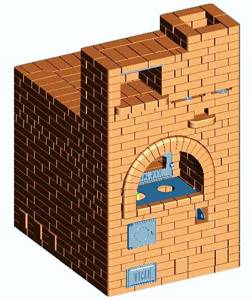
Preparatory work - installation of a reliable foundation. Keep in mind that after pouring the foundation, the formwork can be removed after 3-4 days (during the warm period), and the stove can be built only after 2 weeks. The base area is covered with waterproofing - roofing felt folded in half.
How to properly lay out a full-size “Teplushka”:
- Row No. 1 is continuous, consisting of 65 ceramic bricks. On the second tier, we begin to form the walls of the furnace and support columns, and install the door of the ash chamber. We install 8 stones on a poke without mortar and cut them to the height of the 3rd row. We do not connect it with the rest of the masonry - these will be cleaning hatches.
- We place the third tier according to the diagram, on the 4th we cover the ash pan. On the 5th row, we begin to build the walls of the firebox from refractory, insert a grate 415 x 240 mm.

- Rows 6 and 7 continue to be laid according to the pattern, fireclay stones are placed on the edge. After the formation of the 7th tier, we install the firebox door and the summer valve installed vertically. Rows 8-9 are built according to the order.
- On the 10th tier we cover the floodplain and cover the upper ends of the refractory bricks with kaolin wool. The front part of the chamber must be covered with fireclay block ШБ-94 or similar. We begin to reinforce the walls of the furnace with galvanized wire mesh, then we arrange a re-covering of red bricks (row 11).

- On the finished 11th tier we insert the stove and grate bars of the main chamber - the furnace. We make level No. 12 according to the order and install a large door. Then we lay out the 13th tier and arch using a circle.
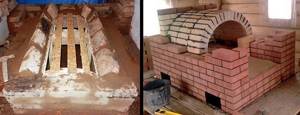
- We build rows 14-17 according to the drawings, raising the outer walls of the furnace, the smoke channel and the front partition of the furnace. Next we lay an arched vault R = 60 cm made of wedge bricks. We continue to build tiers 18 and 19 according to the diagrams.
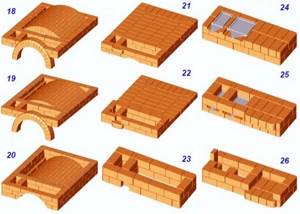
- In the twentieth row we block the front arch and raise the outer walls higher. We fill the void above the vault with a solution of clay and sand. After drying, we build tier 21 - the plane of the bed.
- Tiers 22-32 make up the front section of the stove, where the chimney is combined with the side flue. We line up the rows according to the diagrams, on the 24th level we install 2 valves, on the 29th level we place a sheet of metal covering the stove.
The expert will give step-by-step instructions for building a Russian multifunctional stove in his video:
Miniature stove made from a can
This stove option is perfect for those who like to relax in nature. The finished product has minimal weight and takes up very little space in a hiking backpack. Despite the simplicity of its design, a stove made from a can is very convenient and productive - you can boil a liter of water by spending a few small dry branches.
Moreover, such a homemade stove can work not only on branches, but also on leaves, cones and even hay. You definitely won't remain hungry!
The first stage is preparation of components
Prepare three tin cans of different sizes in advance. Canned food containers are perfect. From the largest can you will make the body of the stove, place a medium-sized can in the body, and from a small container you will make an impromptu burner.
Additionally, prepare scissors, a block, an electric drill and a felt-tip pen.
The second stage is making a template
First step. Insert a wooden block vertically into the largest jar and, approximately at the level of the lid, mark a couple of lines on the wood at a distance of about 8 mm.
Second step. Cut a rectangular recess according to the markings, such a size that the upper edge of the container can freely fit into it.
Third step. Place the block so that the can rests steadily on it, and the upper edge of the large can is held in the previously prepared recess in the block.
The third stage - preparing a large jar
First step. Draw a line over the bottom edge of the largest can. This line will serve as a marking to create ventilation holes. The line can be drawn with an ordinary felt-tip pen.
Second step. Drill holes along the marking line. The optimal number of holes can only be selected experimentally. Excessive ventilation will cause fuel to burn too quickly, and if there is insufficient draft, the stove will simply not be able to operate normally.
Therefore, make a small number of holes to begin with, and then, if necessary, drill them after the initial tests of the stove.
Stage four - preparing the middle jar
Drill many holes in the bottom of a medium-sized container. Select the size and number of these holes so that the loaded fuel does not fall out in the future. As a result, the bottom of the jar will look like a sieve.
Fifth stage - stove assembly
Place a medium-sized jar into the largest container. The connection should be quite rigid, but not tight - a small gap is required between the walls of the two cans for air circulation.
Stage six - making the burner
To create the burner, use the smallest tin can.
First step. Prepare holes in the side of the jar in the same way as you did with previous containers.
Second step. Cut out the bottom of the can using tin snips.
Third step. Carefully align the edges of the burner and clean them with a file.
Stage seven - checking the stove
Take the main part of the stove (a middle container inserted into a large one) and load fuel into it (cones, wood chips, leaves, small branches, etc.). If possible, load dry branches directly from trees into the oven, because... Fuel from the ground may be damp.
Light the load and let it warm up. At first you may not be very good at it, but very soon you will learn how to light a stove with just a couple of matches.
Let the fuel burn intensely, place a burner on the stove, and a saucepan, kettle or other container on it.
How to fold a stove: step-by-step laying, photo
Step-by-step instructions for laying furnace elements:
- Sub-bake. Not all types of stoves have a firewood drying compartment. You can use reheated brick for it. An arch is installed above the oven using a special arc-shaped formwork (which is best made collapsible).
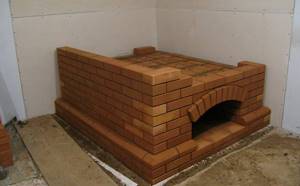
Photo 6. Finished brick oven. Used for storing firewood and other materials.
- Firebox. It is installed on the ceiling (arch); fireclay bricks are used for its laying.
- Under. The bottom of the combustion chamber is often made inclined towards the hearth. For this, a backfill of clay and sand is used.
- Crucible. This element is the most difficult when laying a stove. Its walls should be as smooth as possible. They are erected at a slight slope from hewn fireclay bricks. The furnace ends with an arch - the mouth, where a damper is later installed.
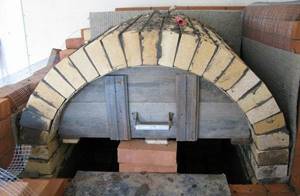
Photo 7. The process of building a crucible, it is the most difficult to build. Used directly to start a fire.
- Firebox vault. Like the arch of the oven, it is made using special formwork. The width is half a brick. The surface of the firebox roof should be as smooth as possible. To ensure the strength of the vault, each middle brick of the row is hewn in the shape of a wedge.
- Six. The compartment in front of the cooking chamber consists of a base, a wall with an arch and side walls, as well as a vault with a chimney opening. It is laid out from ceramic bricks at the same time as the crucible.
- Reroof. Upper part of the oven. The masonry is made of brick in 3 rows. To comply with fire safety rules, the distance from the ceiling to the ceiling of the room must be at least 35 cm.
- Chimney. It is laid out especially carefully; its internal walls should not have protrusions to avoid the danger of soot accumulation. The seams should be tight and without cracks.
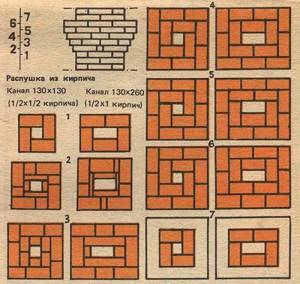
Photo 8. Sequential diagram of the order of the chimney for the stove. Contains seven stages.
As the furnace is being built, dampers and doors are installed, which are purchased in advance. After the masonry is completed, the stove is usually treated with a special heat-resistant putty or plaster to better seal the seams.
What materials will be needed for construction?
- red brick – 750 pcs.;
- fireclay clay;
- sand;
- felt or asbestos fiber for insulation;
- roofing felt on the bottom layer also for heat and waterproofing;
- fasteners;
- metal corner, sheet and steel wire;
- grate – 2 pcs.;
- doors for the combustion chamber and ash pan – 2 pcs.;
- damper – 1 pc.;
- valve – 1 pc.
... and tools:
- building level;
- spatulas;
- Master OK;
- drill with a mixer attachment for mixing the solution;
- buckets;
- sieve for sifting clay and sand.
Don’t forget about the tools: spatula, trowel, drill with mixer. Additionally, have buckets or tanks and a sieve on hand. To ensure the oven is level, use a level.
Heating stove
Now let’s see how to build a brick stove with your own hands, designed to heat a small country house.

Its dimensions:
- width – 2 bricks (51 cm);
- depth - 3.5 bricks (90 cm);
- height – 2 meters 38 cm.
For construction you will need the following materials and accessories:
- Red solid brick – 390 pcs;
- Clay - 9 buckets;
- Sand - 18 buckets;
- Grate (25x40 cm) – 1 piece;
- Fire door (20x30 cm) – 1 piece;
- Blower door (14x20 cm) – 1 piece;
- Cleaning door (14x20 cm) – 1 piece;
- Gate valve - 1 piece;
- Pre-furnace steel sheet (50x70 cm) – 1 piece;
- Roofing felt for waterproofing (100x60 cm) – 1 pc.
Sequence of work
The first row is the base of the oven. It should be laid out especially carefully, checking the horizontality using a level.
The corners are the hardest part for beginners. To ensure that they are even, we recommend immediately installing four template posts on the edges of the masonry. They can be made from planed boards, knocking them down in pairs at right angles.
By installing such “formwork” from floor to ceiling, you can easily create ideal angles.
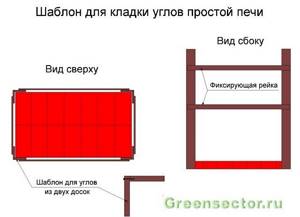
On the second row, two bricks with a beveled edge facing into the ash chamber are laid at the end of the furnace. The laying of the third row begins with the installation of a blower door, fixed with wire in the seams of the side bricks.
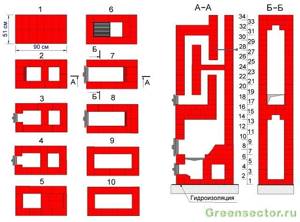
Rows 4 and 5 continue to form the walls of the ash chamber. In the sixth row, they begin laying the walls of the fuel chamber and install a grate in it.
At the level of the 7th and 8th rows, a combustion door is installed. At the back of the chamber, beveled bricks are placed to improve traction. The ninth row covers the firebox door.
From rows 10 to 16, the fuel chamber and vertical smoke exhaust duct are being laid. On the seventeenth, a cleaning door is installed in the oven.
Rows 18-30 form smoke circulation channels. They need to be laid out as evenly as possible, rubbing the inner walls with a wet cloth.
Rows 31-32 form a vault covering the oven.
33 and 34 form the chimney.
Having finished laying, the stove is left for a week with the doors and pipe open to dry. After this, a test fire is made, burning small portions of wood chips, branches or straw.
The problem of heating country houses and country houses is associated with the lack of a central supply of coolant and gas. Many have already become disillusioned with metal potbelly stoves, but a small brick stove - built with their own hands - gives comfort and warmth, which cannot but rejoice.
Even the smallest brick stove can not only warm up a house, but also decorate it.
Distinctive features of the Russian mini-oven
Fundamentally, a miniature stove is no different from an ordinary Russian stove - it has a similar design, the same functions, the same design. The main distinguishing feature is the size: it takes up significantly less space on the floor due to the fact that the stove and furnace are arranged and located next to each other.
The floor area occupied by the structure is usually no more than 1 m x 1.3 m, but other options are possible, slightly larger or smaller. The height of the structure is the same as usual: the main part at the top smoothly transforms into a cross-pipe and ends with a pipe going into the ceiling.
Both the large cooking chamber and the stove are actively used for cooking. A small firebox heats up quickly enough, so it is used in the summer when heating the entire house is not needed. You can easily place 2-3 pots at once on the burners, and if a large oven is heated, you can bake bread.

It is easier to choose a place for a mini-stove: it can be successfully installed both in the corner and in the center of the room, as well as built into a partition or wall
The stove also stays hot for a long time, so it can be used for reheating or just keeping breakfast or lunch warm.
A special feature of the compact stove is the preservation of two fireboxes, which are used with the same activity. But they are often located on two opposite sides - in this case, a free approach will be required from both the front and the back.

After heating, the walls of the structure retain heat for a long time, and although the mini-stove is smaller in size, the heat transfer is enough to heat a room of 25-30 m²
It must be remembered that a mini-copy does not differ in the level of danger from a large Russian stove, so during construction it is also necessary to insulate the foundation and nearby surfaces susceptible to fire. Walls, wooden floor areas, and the edges of openings in the ceiling are sheathed with metal or asbestos sheets.
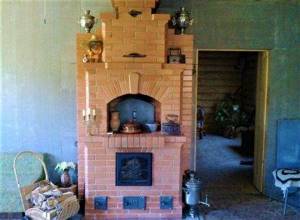
Difficulties may arise for those who want to build a bed - of course, the mini-option does not provide a full-fledged place to relax, the occupied area is too small. However, you can build in a niche for drying, just like installing a small hot water boiler
Russian stove in the house: pros and cons
It is important to consider the advantages and disadvantages of the design
It has many advantages:
- the heat flow is characterized by low density, and the heating surface area is very large, therefore the heat is always soft, the air does not dry out, and the effect has a healing effect;
- a well-designed and built Russian stove ensures a warm rest on the stove bench, even when the temperature in the house is low;
- part of the heat flows is transferred to the foundation and adjacent soil layers, drying them - the risk of swelling and subsequent deformation is reduced;
- with good heating, the heat lasts for several days, so after a long working day or several days of absence the owner will not freeze in the house;
- food cooked on a stove has a special taste and aroma - even simple dishes become tastier;
- There are several fuel options - firewood, straw, peat, reeds, dung.
This structure is well suited for houses where people live permanently.
Its main disadvantages include:
- costs of materials - for a similar amount you can build a fireplace and 2 Dutch stoves;
- long heating - it takes 3-4 hours, and the room warms up to maximum 2-2.5 times longer;
- a complex device, this applies to smoke channels, combustion chamber, vault layout.
The size of the modern Russian stove has become more modest. Today they prefer more compact designs with a stove, often abandoning beds. For clarity, before construction, you can make a model from boxes with your own hands. Previously, the structure did not warm up below. Flooding solved the problem. The Russian stove with heating is attractive due to its uniform heating and the possibility of partial kindling on non-cold days.
Some tips for safe operation
- After a long period of inactivity, be sure to check all visible surfaces for tightness of seams. Any cracks that appear must be repaired with clay mortar.
- Before each fire, check for draft. If smoke from the furnace enters the room, the stove must not be used under any circumstances. Perhaps one of the valves is closed or the chimney needs to be cleaned.
- You can close the view only after the firewood has completely burned out.
- It is recommended to remove soot from the internal surfaces of the stove at the beginning of each season. In fact, the stove gets dirty very little and after construction it will not require cleaning for several years. However, it all depends on the smokiness and quality of the fuel used.
Mortar for laying the stove
The thinness and elasticity of the composition and the absence of cracks after drying are important. You can use a ready-made mixture from the store or make it yourself. For this you need purified clay. It needs to be soaked in water, and after a day kneaded with sand - first, several variations of the solution are made for testing, changing the proportions. From each they form cakes, 1 cm thick. After 2-3 days they are examined - where there are fewer cracks, the composition is better.
66cc21e0577ca4d907f14c51c1e7267e.jpe

To ensure uniformity of the clay, after soaking it is wiped through a mesh with 0.5 cm cells. When preparing the solution for the firebox, it is better to replace ordinary sand with fireclay powder. Mix it with clay 1:3(4).
